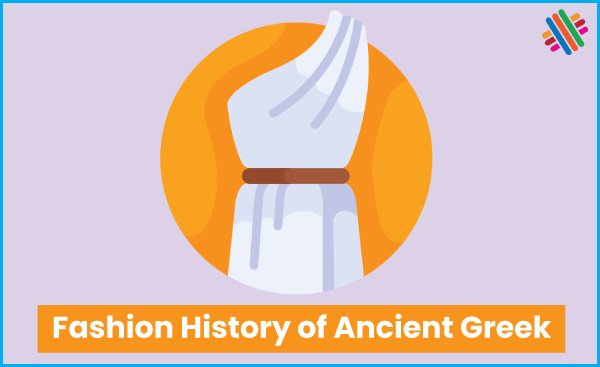Fashion History of Ancient Greek
Last updated on September 26th, 2023 at 11:33 am
The civilization of ancient Greece has left a rich heritage to posterity in her chaste and refined simplicity of dress. It is to the costume of Greece of twenty five hundred years ago that we turn for grace, beauty of line, refinement of detail, and unity of composition. In the study of Greek literature, painting and sculpture we may develop an appreciation of the entire field of Greek costume. Greek culture laid the foundation of European civilization. Land was mountainous and the only means of communication was the sea. It had the world’s first dramatically development. However, in Greece, women, slaves and foreigners were not considered important. They were not given the right to vote. People were fun loving, fond of music and believed that life after death was inferior. They buried as well as cremated their dead ones.

The basic garment of the Greeks was vest. It was a rectangular piece of material with no stitching. Therefore the costumes of Greeks were a draped costume. Depending upon the method of wearing it, it can be divided into five categories.
The draped costume
This was the unstitched costume obtained by draping a piece of material around the body. e.g. the Himation and the Grecian pareo.
The slip-on costume
The slip-on costume is made from one piece of cloth or skin but with a hole from the head and hanging from the shoulders e.g. poncho and huque.
The sewn costume
This is made from several widths of material assembled or placed lengthwise and worn over other garments and crossed in front e.g. kaftans.
The sheath costume
This is fitted closely to the body and legs e.g. pants and breaches.
The dresses for all the classes were same except for the difference in the quality of material and arrangement of cloth. Another special feature of Greek costume was that the garments for the men and women were the same except for their length.
Ancient Greek Costumes
The chiton
This is the basic undergarment of the Greeks. It was fastened at the shoulders by pins and at the waist by a girdle or sometimes without girdle. It could be knee length or till mid-thigh (for men) or ankle length (for women). Girdle on the waist created a baggy effect known as kalpos. The chiton varied with geographical variation.

Doric chiton was a long tunic up to the ankles gathered in at the waist with a girdle but without sleeves. The Doric chiton was made for poor people and ordinary soldiers. It was made of cheap coarse thick material like wool.
Ionic chiton is also a full length tunic but with sleeves. The material should be clasped at intervals over the arms forming loose sleeves. Men sometimes wore the chiton fastened only at the left shoulder leaving the right arm free.
Sometimes the second belt was worn around the hips giving blouson effect. Both men and women wore full length chitons for functions and ceremonies.
The chiton could also be up to the knees. Earlier it was made of linen, and then of silk, with embroidered borders.
Peplos
It was short length chiton, mainly worn by women. It is a rectangular piece of woolen fabric fastened to the shoulder like chiton, the only difference that it was belted and arranged in artistic folds and weighed down by pellets.

Chlamys
It was a light summer cloak worn by young men over the chiton. It measured 1X2 yards and was made of light wool. This was made from rectangular material but falls in triangular points. The chlamys also has metal points attached to the corners. The Chlamys could be worn in many ways. It could be attached by a fibula at the right shoulder so that the left arm is covered while the right arm remains free. The Chlamys could also be pinned at the throat and thrown back over the shoulders. It served as a covering against the weather.
Himation
It was a large cloak worn by men and women, measuring 1.5 X 3.5 yards. It was worn like a large chadar (big shawl) on the shoulders and was belted. The folds and pleates are the characteristics of a Himation. The arrangement of a Himation reflects a person’s creativity. Pleates were made by wetting the garment in starch, twisting it carefully and laying it out in the sun to dry. The amount of cloth used in a Himation depended upon a person’s class. Himation was made of wool or linen.
Palla
The most interesting outer garment of the Greeks was the palla. It was fixed at the shoulders with pins leaving the arms free. The palla is a feminine garment worn up to the waist.
Talaris
Talaris is an outer garment having wide sleeves which hang gracefully. Both men and women wore talaris, usually made of linen and fastened with girdle.
Chloene
It was a simple outer garment of square warm material. A piece of metal was attached to each corner so that it hung gracefully.
Pharos
It is a small cape usually decorated with stars. It is made from a woolen material attached at the throat by a broach or fabulic.
Zodiote
It is a tunic trimmed with animals and flowers.
Pallium
It was a famous over garment that was draped over the left shoulder.
Catastictors
It is a robe of many colors.
The only method of fastening was with pins or broaches known as fibulae. These were sometimes highly decorative. As a headgear, mantel was usually used in the rainy season. Diplodine was another headgear used to cover the head. Greeks were fond of curly hair and used to tie them in a knot with net at the back. They spent a lot of time arranging their hair. Women used a veil which was a sign of modesty. They used to decorate their hair with ribbons, flowers, beads and circles of metal. Hairs were long and dyed. Married women pilled up their hair on the top of the head and pinned up the knot. Pins used to secure the hair were called diadems. Sandals of wood and leather were worn, which was considered as a costly item of dressing.
Fans and sun shades were used. Men, during travelling used to wear broad hats tied under their chains, called pilarus. The two belts (girdles) worn by women were called stropion and zona. Small earrings, bracelets, and delicate necklaces were worn by women.
The people of this era thought that bay leaves, honey suckle and laurel leaves were considered sacred. They took an inspiration from these for designing cloths and jewelry. Laurel leaves were especially given to the athletes. Wreathes were made of these leaves and tied around the forehead. Geometrical designs or natural designs were of great importance, e.g. oak leaf, laurel leaf, olive leaf and acanthus leaf. A lot of beauty is seen in the cloths of the Greeks. The draped costume of the Greeks was considered very graceful and had simplicity on its lines.

Greek women washed her with water mixed with ambrosial fluids (made from an herb). She used to apply dye on her hair and then washed it. Dye could be black, sky blue, and honey colored or red. Hair would even be dusted with golden powder. Whatever the color of the hair, the eyebrows were always black. Clean hairs were curled with hot irons. Soap made of clay compound was used.
In dressing up, they first wound a band of material beneath their breast. Next came the chiton which was of various styles. Over the chiton, they wore a palla, or Zodiac etc. The desire to be admired led the woman of Greece to adopt all the artifice that could be devised at that period. All these ornaments were kept in a cascade. She also used a fan and sunshade while going out.
You may also like: History of Fashion in the Roman Period




This seems a bit out of the loop-could you add some detail?
Thank you for your articles. They are very helpful to me. Can you help me with something?
Your articles are very helpful to me. May I request more information?